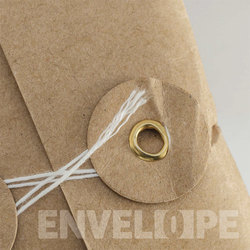Читать книгу Envelope - Peter Quinn Davis - Страница 3
Introduction
ОглавлениеThis exhibition is called Envelope. It has developed over a period of time from ideas of value and especially what designers, from all disciplines of design, might consider to be of value.
Designers create or add to the visual, experiential, the built, and object legacy of our world. What they leave is rarely about themselves, how they might think and act; this is mainly because of the reality of commercial relationships. But there is a feeling now that designers are taking up more of a position to question these relationships.
This exhibition asked designers to send through the post things they value, things that transfer to an object or experience and says something about them. They have responded graciously and generously, with expense to themselves in time and effort and we thank them for it.
The exhibition details how designers might think about their tools, their products, their past and their futures, their ‘cant do without’s’ and most of all their love of what they do.
Envelope in some ways is an ironic title for an exhibition in the 21st century when our postal services are distributed by different global networks and our means of communications have changed so radically, but for the purpose of the exhibition it works as a metaphor and a slightly nostalgic one at that.
As a curator it’s been a little like knowing you are going to be injured in someway, but not quite knowing what the extent of those injuries might be. As the call went out to designers, crafters, illustrators, graphic communicators, architects, service designers etc., we took a tremendous risk on what the responses would or might be. Would anyone send anything, what would they send, could they be bothered, would they be too busy, would they grip on to the idea?
To send something, anything, through the post is a challenge, it’s challenging because it’s a trust in a system, it takes a physical presence to get it underway and it requires a few differing actors along the way to get it to where it’s going. The result, as something arrives, keys into the basic pleasures of gifting, unwrapping, reflecting and understanding, why and how this is meaningful for the designer. The exhibition seeks to explore the changing role of value within contemporary culture and especially designer relationships to value and what constitutes the tools of their trade and or the materials they use to deliver design, or in fact things they have around to deliver inspiration or meaning, all this in the many different roles and contexts of practice.
Design is now often linked to the emerging emphasis upon new skill sets and professional roles, the development of innovative methods and tools, future materials, and the impact of digital technologies and data sets. Design has always moved quickly to respond to societal changes, but now design, and the role of the designer, is shifting to allow changes within a trans-disciplinary, multi-institutional and global context. In the coming years designers will work alongside social entrepreneurs, scientists and policy makers, just as readily as manufacturers or technologists. I think this points to design not still/just solving/adding to the existing problems, but transforming into an epistemological practice (describing the forms of knowledge and modes of knowing that inform our actions) to be future focused and knowledge generating.
The exhibition has some historical context in mail art or the correspondence art phenomenon driven from the Fluxus movement of the 50/60s. The community who used this form valued the interconnectedness of the participants and promoted an egalitarian ethos that frequently circumvents official art distribution and approval systems such as the art market, museums, and galleries. Mail artists rely on their network as the primary way of sharing their work, rather than being dependent on the ability to locate and secure exhibition spaces. The community embraces this outsider or alternative status, and refers to itself as “The Eternal Network” or just “The Network.” At its core, mail art is about interpersonal communication, exchange and the creation of a virtual community of participants. In this way, mail art can be seen as anticipating the cyber communities founded on the Internet today and what we now know as the open source or digital communities.
While developing the exhibition on that train journey down to Marseille, keeping in touch with the reality of travelling fast, under the design guidance of Jacques Cooper (à Grande Vitesse) and trying hard not to get too pretentious or melancholic, it was not to ignore the mediations of Jacques Derrida and his book The Postcard. The book details a somewhat retro love letter, the last in history. Its lack of address allows it to fall into ‘all hands’ a bit like a Twitter outburst. In the postcards a secret appears, but indecipherably, written as a series of love letters from the narrator to an unnamed lover. The letters recount the story of their love affair alongside reflections upon the history of the post and on psychoanalysis. It contains references to real people within the academic world in which it is set and with this its sense of places; Oxford, Paris and Yale. This in many ways grapples with the relationship between representation, adaptation and deconstruction: some of the many complexities designers will also have to wrestle. The exhibition tries to key into these in a rather modest way.
Peter Quinn Davis
